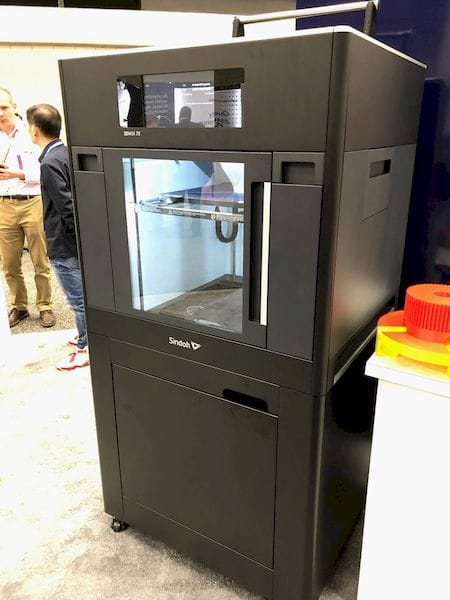![The coming 3DWOX 7X professional 3D printer [Source: Fabbaloo]](https://fabbaloo.com/wp-content/uploads/2020/05/image-asset_img_5eb09bfb796ac.jpg)
We managed to get a peek at a rather large device coming from Sindoh, the 3DWOX 7X.
This is a bit of a departure of sorts for the company, which up to now has produced only desktop-style 3D printers of much smaller size. The 3DWOX 7X, however, is a beast that sits on the floor and is considerably larger.
Like its siblings, the 3DWOX 7X uses filament extrusion as its 3D printing process, with 1.75mm filament format employed. The machine can print layers as small as 0.05mm, which is just about the best that can be achieved by most extrusion 3D printers.
As you might expect, the 3DWOX 7X has a vastly larger build volume of 380 x 390 x 450 mm, many times larger than other 3DWOX models. Inside the build chamber, you’ll find a spring steel removable plate that allows for quick and easy print removal. The 3DWOX 7X includes full automatic leveling, another change from the other models in the 3DWOX line, which offer only assisted leveling.
Another very intriguing feature is that the build chamber is apparently explicitly heated. This could allow for precision control of temperatures during printing that could increase print quality and reliability, or even permit the use of new materials.
The big change — other than the build volume — is that the 3DWOX 7X includes dual independent extruders. This is a more frequently found feature on some advanced 3D printers, but it’s still not on many machines. Now, the 3DWOX series includes it.
Dual extruders allow the use of two different materials in a single print job. Quite often this doesn’t mean simply using, say, two different colors, but rather one extruder is loaded with dissolvable support material. This allows the 3DWOX 7X to easily 3D print highly complex geometries with delicate elements. There would be no stress in removing support material as in other devices; no need to damage fragile components — the support simply dissolves away.
While dual extruders are quite useful, the 3DWOX 7X extruders are independent. This means the machine could potentially perform some interesting print job maneuvers, including: print twice as fast; print duplicate copies, print mirrored copies. We’re not sure which, if any, of these will be implemented by Sindoh.
There’s another unique feature of the 3DWOX 7X’s extruders: they are both Bowden and Direct. It seems they are trying to do push and pull on the filament, perhaps due to the size of the machine. This is not a common approach, but I have seen it on Stratasys FDM machines.
By the way, they also intend to add swappable nozzles in a few different sizes. This will allow use of larger nozzles to reduce print time on large jobs.
The 3DWOX 7X includes a massive 10.1” color touchscreen for operational control. Its networking options include WiFi, USB and direct connect ethernet. Like all 3DWOX printers, there’s also an onboard webcam, noise reduction feature and a HEPA filter.
The big question many might be wondering about is whether the 3DWOX 7X must use proprietary material cartridges as was required by earlier Sindoh machines. The good news is that the 3DWOX 7X will accept “open material”, in much the same way as the company’s 3DWOX 1 machine.
Sindoh says the 3DWOX 7X will accept a variety of materials including PLA, ABS, Flexible, PVA (all from their own catalog), and PLA, ABS, ASA, PETG, PA and other open materials. Sindoh says they are also intending on providing print profiles for certain third party filaments, which should increase ease of use considerably. This seems quite powerful! The machine is able to accept 1kg spools, but might be able to fit 1.5kg spools depending on the machine’s final design.
Sindoh hinted that they are considering enabling the machine to use PEEK material at a future point. However, this would require raising the temperature of extrusion to around 400C, as well as thermally conditioning the build chamber to withstand much higher temperatures. This sounds to me like they’re thinking about a future “3DWOX 7X HT” version.
We’re told the machine is likely to be released sometime near July of this year, and could cost around US$15K, which sounds like quite a good price for a large sized machine with this level of features.
Via Sindoh











FELIXprinters has released a new bioprinter, the FELIX BIOprinter, which is quite a change for the long-time 3D printer manufacturer.